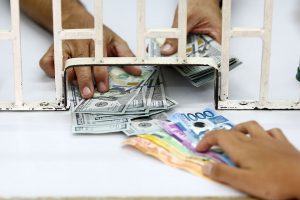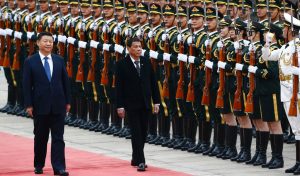Peso sinks to new low of P58 on hawkish Fed bets

THE PESO plunged to a new record low of P58 on Wednesday as the dollar remained strong on expectations of a huge rate hike from the US Federal Reserve overnight.
Analysts said the Philippine central bank may likewise need to be more aggressive to support the local currency and reduce its depreciation’s impact on domestic inflation.
The local unit on Wednesday sank by 52 centavos from its P57.48 finish on Tuesday, Bankers Association of the Philippines data showed.
Year to date, the peso has weakened by 13.72% or P7 from its P51-per-dollar close on Dec. 31, 2021.
Just for this month, the peso has lost 3.3% or P1.855 in value versus the greenback so far from its Aug. 31 close of P56.145 as the dollar hit new highs following Fed Chief Jerome H. Powell’s statement at the Jackson Hole symposium late in August that the US central bank may keep rates higher for longer to stem inflation.
The local unit opened Wednesday’s trading session at P57.70 versus the dollar, which was also its intraday best. Its weakest showing was its close of P58.
Dollars exchanged climbed to $1.05 billion on Wednesday from $967 million on Tuesday.
“The peso closed significantly weaker at exactly the P58 level amid the possibility of a strong 100 bps (basis points) US policy rate hike from the Federal Reserve,” the first trader said in an e-mail.
“The peso’s weakness was caused by broad dollar strength as Fed is expected to hike rates by 75 bps,” a second trader said in a Viber message.
The Fed was expected to announce another huge rate increase and signal more hikes at the end of its Sept. 20-21 policy meeting overnight. It has raised borrowing costs by 225 bps so far since March, including back-to-back 75-bp rate increases in June and July.
With the dollar’s strength causing the peso to hit a fresh all-time low, the Bangko Sentral ng Pilipinas (BSP) may need to deliver a larger rate hike at its Thursday meeting to keep inflation expectations anchored, former Philippine central bank deputy governor Diwa C. Guinigundo said.
“US Fed is expected to do a 75 to 100 bps while the consensus here is a BSP move of 50 bps. It might even be necessary to outdo the market and deliver a higher blow to inflation,” he said in a Viber message.
“That would further assure the market of monetary policy decisiveness, help firm up the currency and cement inflation expectations,” Mr. Guinigundo added.
He said while the BSP “remains on the tightening offensive,” aggressive actions from the Fed would make the dollar more attractive.
“The external payments position at nearly $5.5-billion deficit for the first eight months of 2022 is not helping any because imports remain so much more substantial than our export earnings, and the decline in FX (foreign exchange) reserves to just about $97 billion could further fan market nervousness and contribute to the peso weakening further. Given the exchange rate pass through, that could further be inflationary even as the pass through has shown some reduction since 2002,” Mr. Guinigundo added.
The BSP Monetary Board will meet to revisit policy settings on Sept. 22, Thursday, where it is widely expected to fire off another 50-bp rate increase to tame inflation. It has hiked borrowing costs by a cumulative 175 bps since May.
Headline inflation eased to 6.3% in August from a near four-year high of 6.4% in July, bringing the eight-month average to 4.9%, both above the BSP’s 2-4% target for the year.
Meanwhile, for the first eight months of the year, the country’s balance of payments deficit widened to $5.492 billion from the $253 million seen in the same period in 2021, latest central bank data showed.
This reflects the final gross international reserves level of $97.4 billion at end-August, down by 2.4% from $99.8 billion as of July.
Rizal Commercial Banking Corp. Chief Economist Michael L. Ricafort likewise said in a Viber message that a bigger-than-expected increase from the BSP will support the peso, inflation and price expectations.
“Rate hike expectations continued to put pressure on the peso today (Wednesday), and as such, the BSP should opt for a stronger message by way of clearer forward guidance beyond the actions tomorrow (Thursday),” Security Bank Corp. Chief Economist Robert Dan J. Roces said, noting a weaker peso poses upside risks to inflation.
For Thursday, Mr. Ricafort gave a forecast range of P57.85 to P58.05, while the first trader expects the local unit to move from P57.80 to P58 per dollar. — Keisha B. Ta-asan




